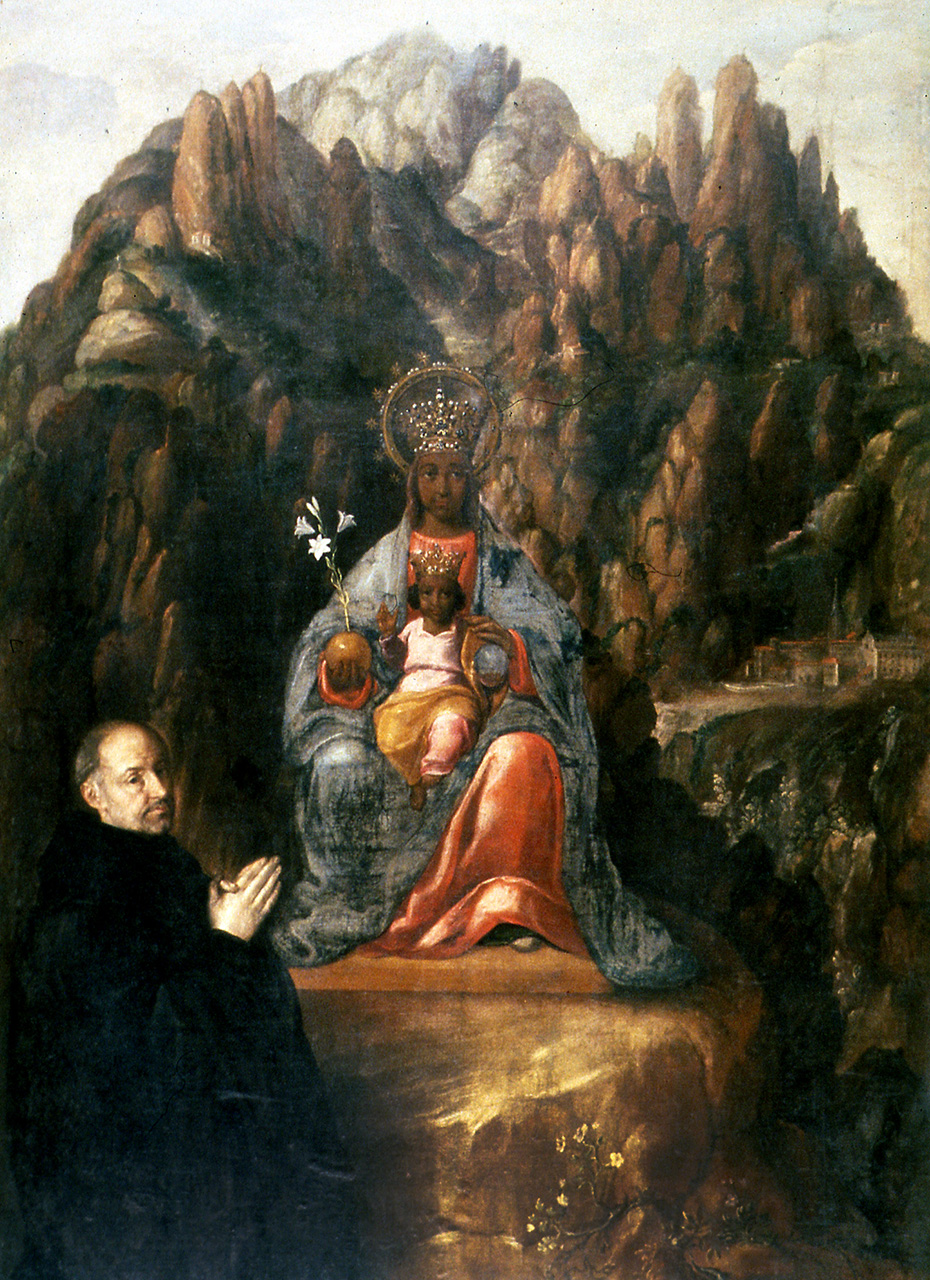
The Virgin of Montserrat with a Donor
The twelfth-century statue of the Black Virgin of Montserrat is one of the most venerated Marian images in Spain and one of many figures of black Virgins located in churches and monasteries across Europe. According to legend, St Luke created the statue of the Virgin of Montserrat in Jerusalem and St Peter later brought it to the Iberian Peninsula. Medieval and early modern religious writers embellished accounts of the Virgin of Montserrat, placing emphasis on the statue’s survival in the face of an Islamic enemy, first in its original location in Jerusalem, and then in the Peninsula during the Muslim conquest. Popular tradition holds that it was hidden in a cave and forgotten about until its legendary rediscovery in the ninth century.
Scholars have shown that the statue was not originally black but was made deliberately darker in the fifteenth or sixteenth century, possibly to emphasize its alleged antique origins in the East, thus heightening its importance as a cultic figure. In the early modern context, the statue’s blackness must also be considered in relation to Spain’s multi-racial history. Dark skin was mostly associated with the Moriscos (Muslims who had converted to Christianity before being expelled in 1609–14), African slaves, people from North Africa and the Middle East, and the indigenous populations of Latin America. It was from the eighteenth century onwards that writers explicitly defined her in racial terms, as ‘brown’, ‘oriental’, or ‘black’. She eventually became known as ‘La Moreneta’ (or ‘dark one’).
Rizi knew the statue first hand, as he had joined the Benedictine order in 1627 and lived in Montserrat until the outbreak of the Catalan rebellion in 1640, when he moved back to his native Madrid. The artist has depicted the statue with great artistic freedom by showing it in an outside location and giving it a naturalistic appearance. The Virgin is seated on a rocky platform against the distinctive landscape of Montserrat. The Monastery and its Church, where the statue is actually located, is visible in the distance on the right. The figure kneeling on the left may be a patron or a monk. Dressed in black, he looks out of the picture as if inviting us to join him in prayer. As is traditional in Marian representations, the Virgin wears a blue robe over a red tunic, and the Christ Child is dressed in pale pink. Both the Virgin and the Child wear a golden crown and hold an orb, symbolizing their dominion over the earth. The white lily mounted on the Virgin’s orb signals her purity, while Christ raises his right hand in blessing, conforming to his role as Saviour of the World.
In Rizi’s time, King Philip IV publicly demonstrated his sympathy for the Virgin of Montserrat, and an image of her, based on Rizi’s composition, was used in religious festivities organized in Madrid to celebrate his victory at Lleida during the Catalan revolt in the 1640s.
Rizi painted several versions of this subject. The example at The Bowes Museum appears to have been commissioned by the Monastery of Saint John in Burgos, where it remained until 1832, when it was taken to Madrid as part of the government’s project to create a National Museum in the convent of La Trinidad, under the direction of Count of Quinto. John Bowes purchased the work from his widow in 1885.
 Click to zoom and pan
Click to zoom and pan
...
Your feedback is very important to us. Would you like to tell us why?
We will never display your feedback on site - this information is used for research purposes.
Artwork Details
Title
The Virgin of Montserrat with a Donor.
Artist
Juan Andrés Rizi (Madrid, 1600 – Monte Cassino, Italy, 1681).
Date
c. 1645.
Medium and Support
Oil on canvas.
Dimensions
264.5 x 1676.5 cm.
Marks and Inscriptions
None.
Acquisition Details
Bequeathed by the founders, John and Joséphine Bowes in 1885.
Previous Owners
Purchased by John and Joséphine Bowes from the collection of the late Conde de Quinto, 1862 (as by Alonso Cano).
Institution
The Bowes Museum, Barnard Castle, B.M.69.
Bibliography
Enriqueta Harris, ‘Spanish Pictures from the Bowes Museum’, Burlington Magazine, 95 (1953, no. 598): 22–25 (pl. 35);
Juan Antonio Gaya Nuño, La pintura española fuera de España: historia y catálogo (Madrid: Espasa-Calpe, 1958), p. 288 (no. 2441);
Eric Young, Four Centuries of Spanish Painting: 17th June – 17th September 1967, The Bowes Museum, Barnard Castle, County Durham (Gateshead: Team Valley Printers, 1967), p. 40;
Eric Young, Catalogue of Spanish Paintings in the Bowes Museum, 2nd ed. (Middlesborough: The Bowes Museum, 1988), pp. 142–45;
José Álvarez Lopera, El Museo de la Trinidad en el Prado (Madrid: Museo Nacional del Prado, 2004), p. 60;
Stella Nair, ‘Localizing Sacredness, Difference, and Yachacuscamcani in a Colonial Andean Painting’, The Art Bulletin, 89.2 (2007): 211–38;
Véronique Gerard Powell, ‘Spanish Paintings in the Bowes Museum’, in Spanish Art in County Durham, ed. Clare Baron & Andy Beresford (Bishop Auckland: Auckland Castle Trust, The Bowes Museum, & Durham University, 2014), p. 80;
Elisa A. Foster, ‘The Black Madonna of Montserrat: An Exception to Concepts of Dark Skin in Medieval and Early Modern Iberia?’, in Envisioning Others: Race, Color and the Visual in Iberia and Latin America, ed. Pamela A. Patton, The Medieval and Early Modern Iberian World, 62 (Leiden: Brill, 2015), pp. 18–50.
